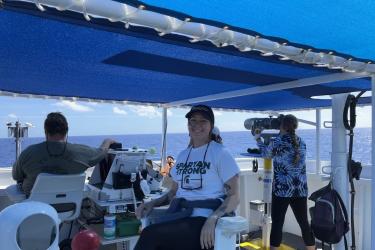We started off strong with most of our team at Midway Atoll and finished up with a smaller team of the “Midway Furious Five.” The five of us had amazing weather for the rest of the mission—little to no rain or wind, which meant it was hot while we cleaned up the beaches. Luckily for us, the calm and cool waters were always welcoming, cooling us off between cleaning or loading our boat full of land debris.
One day, we were walking along a beach on Sand Island, and saw a bird struggling ahead of us. When we approached, we realized that this bird, a booby, had part of an eel cone around his body, holding his wings down so he could not move or fly. Our team acted quickly to free the booby by carefully restraining him while we cut the plastic ring off.



Overall, it took our team of five about 6 days to clean the beaches of Sand Island. The Midway Furious Five collected more than 25,000 pounds of debris in the last 10 days we were on Midway, plus the 30,000 pounds that our whole team collected—totaling over 55,000 pounds on Midway alone!
As we boarded our plane to head back to Honolulu, we all reflected on the last few weeks. While we are super fortunate to spend so much time at Midway and clean the ocean and beaches, we feel a sense of urgency to change our personal habits and influence others to do the same. Looking back at the beaches we had just cleaned, and tallying the amount of plastics and nets we collected felt like such a great accomplishment until, only days later, we would return to see plastics already accumulating again. I could even see some plastics floating, heading towards the islands, from the air. While the beaches are much cleaner, you still probably wouldn’t guess that we had just picked all the plastics and nets, let alone believe your eyes when you saw the piles we collected from them! Beach clean-ups are extremely important, but overall, we need to reduce or eliminate our plastic use or else we will forever be fighting this never-ending battle.

Our marine debris team is very hopeful and excited for the future! We were not necessarily ready to go back home yet but were, at the same time, excited to come home and share our experiences from the mission with family and friends. Stay tuned for our totals from the mission, more experiences post-mission, our outreach events with students, lessons we learned, and how you can help (after all, marine debris really is everyone’s problem).
Meet the Blogger
Kelly Williams
Kelly earned her master’s degree in Zoology from University of Hawai‘i at Mānoa researching shark sensory biology and behavior. If she is not in the water, Kelly is outdoors adventuring or with friends and family. Kelly is excited to get back to the Northwestern Hawaiian Islands, remove as much marine debris as possible, and bring awareness to this global issue.
Follow us
Follow the team as they travel to the islands and atolls of the Northwestern Hawaiian Islands with photos and updates on their Story Map.
Partners
NOAA Fisheries marine debris project in the Pacific Islands region is supported by NOAA (Pacific Islands Fisheries Science Center, Pacific Islands Regional Office, Marine Debris Program, National Marine Sanctuaries, and the Damage Assessment Remediation and Restoration Program) in partnership with the University of Hawaii's Joint Institute for Marine and Atmospheric Research, National Fish and Wildlife Foundation, U.S. Fish and Wildlife Service, Midway Atoll National Wildlife Refuge, the State of Hawaii’s Department of Land and Natural Resources, and the Papahānaumokuākea Marine National Monument.


